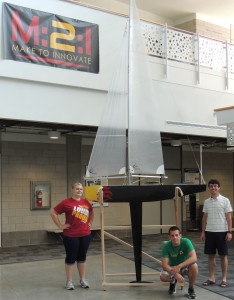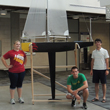
The Aerospace Engineering Department might seem an unlikely host to a sailboat team, however, that is exactly where the ISU Autonomous Sailboat Team originated. Evan McCaw, a spring graduate of the aerospace engineering program, created the group and through a combination of aerospace engineering courses, computer engineering courses, and the Make to Innovate Lab (M:2:I) his idea became reality. The team put their design to the test in the 2013 Sailbot Race, June 9-13 in Gloucester, Massachusetts. Although they didn’t come away with any awards, the team is excited and motivated to apply what they learned in building next year’s autonomous sailboat under the new leadership of Sarah Niles, sophomore in aerospace engineering.
While the sailboat team started out with a handful of students, internships and coursework demands eventually shaped the core member roster to McCaw, Niles, Jordan Schlak, and Robert Beres.
“I came to Iowa State with a strong interest in boats and sailing but no experience with building or designing anything as ambitious as a robotic sailboat,” said McCaw. The recent graduate credits his employment to his experience in establishing the sailboat group. “I’ll be working for the Naval Surface Warfare Center in Panama City, Florida. During my interview process, all they wanted to talk about was the sailboat and the skill set I gained by working on it. Everything I learned about electronics, I learned from this.”
Niles first found out about the team at a M:2:I exhibit. As the owner of a sailboat, the display instantly peaked her interest.
“It combines my two loves – aerospace and sailing,” said Niles. “And people seem confused about a sailboat team from Iowa, but the physics is very similar. Boats are fundamentally like planes, only at 90 degrees.”
From McCaw’s leadership and code he created from scratch, the team gained skills in reading and writing computer code, design, and composite work.
“The aerospace department gave us the tools to make this project come together, and the M:2:I lab had all the resources we needed,” McCaw said. “We accomplished so much more than I thought we would in the time we were given before the competition.”
Niles went on to say that the hands-on nature of M:2:I and her small team allowed for a greater learning experience. In particular, the team learned to implement the vacuum assisted resin transfer method (VARTM). This innovative application of materials and technique by students is the first of its kind.
Jordan Schlak, a transfer student and returning team member was another student who came to the group with an interest in harnessing wind power. Schlak kite boards for fun, and the former psychology major soon discovered the benefit in working with the sailboat team.
“I came into the department with no experience. But I soaked up so much from spending time in the M:2:I lab. It was interesting to see the parallels between designing something for the air and designing something to operate in water,” said Schlak.
In June the team put their creation to the test in the two meter category of The Sailbot race. The race consisted of two classes and five competitions –long distance, navigational accuracy, station keeping, presentation, and fleet race with a human pilot. The ISU team says the friendly competition allowed them to make contacts and learn from other designs.
For the up-coming school year, Niles is eager to build a team of students who will help them experiment with a new design, and make smarter, more efficient code.
“From all we have learned after the experience of our first race, and from the past year, I feel like we could easily place high in the competition next year,” Niles said.
The first SailBot is currently on display in Howe Hall. If you are interested in joining the team, contact Sarah Niles at sniles@iastate.edu or by phone: 319-242-2186. All engineering majors may apply.
